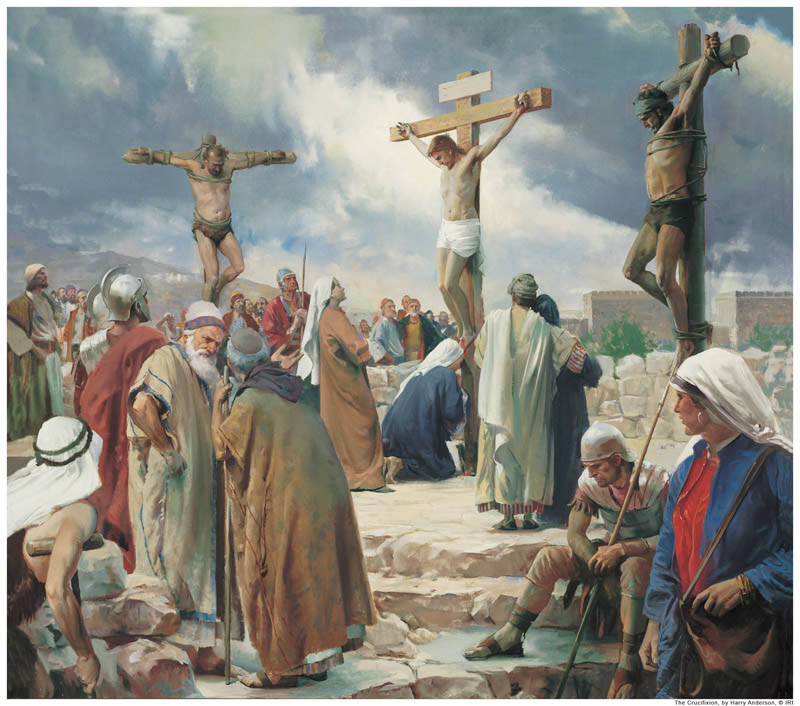At last the verdict was in: Jesus Christ would be crucified. Already weak and exhausted from the Garden of Gethsemane, having stayed up all night being tossed here and there by evil men whose only aim was to see Him hung, by now Christ had suffered more cruelly than any other man on earth. His agony was only added upon by the Roman soldiers.
 Roman regulations insisted that every man condemned to crucifixion be scourged first. This act alone was so brutal, so bloody, those inflicted often died even before they could be crucified. I don’t feel it’s necessary to go into the horrors of scourging here. Just know that it was far more horrible than we can possibly imagine.
Roman regulations insisted that every man condemned to crucifixion be scourged first. This act alone was so brutal, so bloody, those inflicted often died even before they could be crucified. I don’t feel it’s necessary to go into the horrors of scourging here. Just know that it was far more horrible than we can possibly imagine.
After the scourging had passed, the Roman soldiers who held Christ captive here couldn’t quite leave Him alone. Instead they took Him back to the judgment hall where they once again stripped Him of His clothes, mockingly replacing them with one of scarlet, a sign of royalty. Someone braided together a crown of thorny vines. It’s possible each of those thorns were an inch long. He was given a reed to hold, like a scepter, and once again He was scorned.
One of the things that most amazes me about everything Jesus was asked to endure was His patience. Though men spat upon Him, swore at Him, said cruel things to make fun and provoke, Christ patiently bore it all. As He was beaten, slapped, scourged, and other physical abuses were heaped upon Him, Christ never once raised a hand to save Himself. He simply bore all things with patience.
Bruce R. McConkie, a leader of the Church of Jesus Christ of Latter-day Saints (nicknamed the Mormon Church), taught to us follow Christ’s example.
“To fill the full measure and purpose of our mortal probation, we must have patience. This mortal existence is the Lord’s sifting sphere, the time when we are subject to trials, testing, and tribulations. Future rewards will be based on our patient endurance of all things” (McConkie, Bruce R.,Mormon Doctrine, 2d ed. Salt Lake City: Bookcraft, 1966, 557; italics added).
At this time upon Christ’s back was placed the cross He was to carry to Golgotha. We cannot know for certain whether it was the entire cross, or the crossbar. Even the latter would be trial enough, perhaps weighing 75-125 pounds. Christ is generally thought to have carried the crossbar, as crucifixions were generally done on a tree. The bar would have lain across the back of His neck, His arms tied to either side.
In this fashion Christ was prodded along through the streets on their way out of the city (no executions were performed within the city walls. Look up Numbers 15:35; 1 Kings 21:13; Acts 7:58). One of the soldiers carried a sign made by Pilate, indicating Christ’s name and supposed crime, which would later be fastened to the top of the cross.
Only now do we begin to see what toll all of the agonizing events up to this point had taken. Christ, under the great weight of everything He had endured, stumbled. He needed help. A passerby was called to by the soldiers and ‘compelled’ to carry the cross.
It is this man, Simon of Cyrene, who offers us a small ray of light in such a dark moment. Though we don’t know much about him, we do gain the sense that he had nothing to do with Jesus before this moment. He was not among the crowd who had demanded the life of Christ. He was not among those who joined the crowd in mocking and taunting the Savior. He was simply there because Mosaic law required all males of the covenant to come before the Lord during the Passover feast.
This one encounter, however, seemed to have affected Simon deeply. In Mark 15:21 we are given a small clue as to what eventually happened to Simon. “And they compel one Simon a Cyrenian, who passed by, coming out of the country, the father of Alexander and Rufus, to bear his cross.” Simon had two sons: Alexander and Rufus. How does this help us?
Rufus was later referred to in Romans 16:13, where the apostle Paul mentions him, and his mother, specifically. In fact Paul seems to know them very well. We learn an even more interesting fact through a professor at Brigham Young University.
“Archaeologists working in Jerusalem believe that a group of ossuaries (stone boxes for the burial of human bones) discovered in 1941 belonged to the family of Simon of Cyrene…. One inscription bears the name Alexander, a name rare among Jews at the time; he is identified as the Son of Simon” (Skinner, Andrew C., Golgotha, Salt Lake City: Deseret Book, 2002, p.112).
The event that took place the day Simon found himself called forth out of the streets of Jerusalem had such a profound effect on his life he became a converted member to the Lord’s Church, and his family as well.
The thought I’d like to close with, however, is the thought of Simon carrying a load for our Savior. So many times we feel the crosses we are asked to bear are too heavy a load on our shoulders, and we stumble. Often we are told to allow the Lord to help us, for His burden is light. There are few individuals throughout the history of the world who can claim they were able to carry even a tiny portion of Christ’s heavy burdens. Though he may not have thought so at first, Simon’s life was truly blessed for that small act of service.


